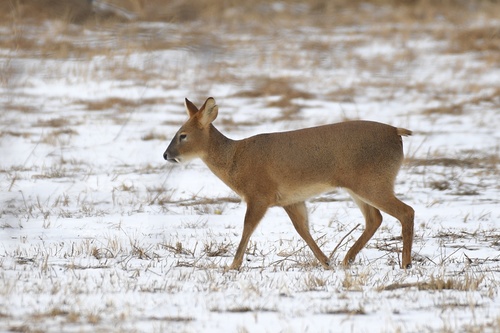
Water Deer
The water deer, Hydropotes inermis, is a unique antlerless deer with striking tusks, native to Asian wetlands. Its solitary nature and preference for aquatic plants highlight its distinct role in ecosystem balance, offering a fascinating glimpse into nature's diversity.
8.62 - 12.7 kg
Weight
Length: 76 - 107 cm; Height: 46 - 56 cm
Size
Brown, Grey, White
Color
5-8 months
Age of Sexual Maturity
3-4 weeks
Age of Weaning
Low
Aggression
Vulnerable
Conservation Status
Decreasing
Population Trend
Characteristics
Hydropotes inermis, also known as the water deer, is native to China and Korea. It lacks antlers, a rarity among deer, but features prominent canine tusks. This small, solitary species thrives in wetlands, feeding on grasses and aquatic plants, and plays a vital role in maintaining the ecosystem balance.
Distribution Range of the Water Deer
Hydropotes inermis, commonly known as the water deer, is native to eastern Asia. Its primary geographical distribution includes China and Korea. In China, it is found in the eastern provinces, specifically in the Yangtze River basin and regions such as Jiangsu and Zhejiang. It is also present on the Korean Peninsula.
Water Deer's Habitat
Environmental Conditions
The water deer typically inhabits riparian zones, marshlands, and wetlands. These areas are characterized by their proximity to water bodies, and they often feature dense vegetation such as reeds, tall grasses, and shrubs. The climate in these regions ranges from temperate to subtropical, with distinct seasonal variations including cold winters and warm, humid summers.
Ecological Niche
Water deer are adapted to environments with ample water sources and thick vegetation, which provide both food and cover from predators. Their ecological niche includes foraging on a variety of plants, especially grasses and sedges, and they are well-suited to wetland ecosystems where their swimming ability aids in escape from threats. Their adaptations to a semi-aquatic lifestyle are unique among deer species.
Copyright @ Nature Style Limited. All Rights Reserved.
 English
English